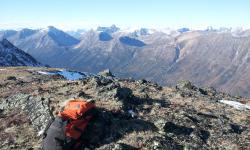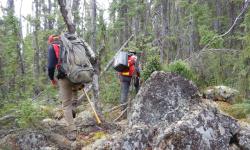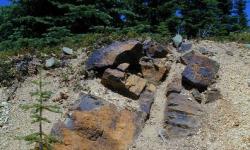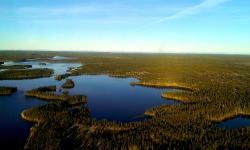Eagle Plain’s Partner Rockridge Files NI 43-101 Technical Report for the Knife Lake Project
Saskatchewan | September 26, 2019Cranbrook, BC, September 26th, 2019 Eagle Plains Resources Ltd. (TSX-V:“EPL”) (“Eagle Plains”) announces that it has been notified by option partner Rockridge Resources Ltd. (TSX-V: “ROCK”) (OTCQB: RRRLF) (Frankfurt: RRO) (“Rockridge” or the “Company”) that Rockridge has filed a National Instrument 43-101 Technical Report to support its inaugural resource estimate (see news released dated August 14, 2019) for the Knife Lake Project located in Saskatchewan, Canada (the “Knife Lake Project” or “Property”).
Rockridge entered into an Option Agreement with Eagle Plains Resources Ltd. to acquire a 100% interest in the Property that covers the majority of the Knife Lake Cu-Zn-Ag-Co VMS deposit (details of the Agreement follow). The contiguous claims total 85,196 hectares and are located approximately 50 km northwest of Sandy Bay, Saskatchewan. A 357kV powerline runs within 16 km of the Knife Lake Deposit area, greatly enhancing the project’s infrastructure.
See Knife Lake VMS Project Map
Highlights:
- Recently completed diamond drilling program plus historical drill core provided data for completion of the first NI 43-101 resource estimate for the Knife Lake deposit (see news release dated August 14, 2019)
- Knife Lake is a near surface VMS deposit starting a few metres below surface and the deposit remains open at depth and along strike for potential resource expansion
- Indicated resources of 3.8 million tonnes at 1.02% CuEq (0.4% CuEq cut-off)
- Or 3.8 MT at 0.83% Cu, 3.7 gpt Ag, 0.097 gpt Au, 82 ppm Co, 1740.7 ppm Zn
- Inferred resources of 7.9 million tonnes at 0.67% CuEq (0.4% CuEq cut-off)
- Or 7.9 MT at 0.53% Cu, 2.4 gpt Ag, 0.084 gpt Au, 53.1 ppm Co, 1454.9 ppm Zn
- The deposit is a remobilized portion of a presumably larger “primary” VMS deposit; most of the historical work has consisted of shallow drilling at the deposit area with little regional work carried out and limited deeper drilling below the deposit
- A summer field program was recently completed with results pending and news forthcoming
Knife Lake Geology and History
The Knife Lake Project is interpreted to be a remobilized VMS deposit. The stratabound mineralized zone is approximately 15m thick and contains copper, silver, zinc, gold and cobalt mineralization which dips 30° to 50° eastward over a known strike-length within Rockridge’s claim area of 3,700 metres, and a known average down-dip extension of approximately 300 metres.
Qualified Persons
Stephen Kenwood, P.Geo., an independent qualified person visited the Knife Lake Property on May 15, 2018 and March 22, 2019 and is responsible for the geology and QAQC for the NI 43-101 Knife Lake Resource Estimate.
Sue Bird, P.Eng., Principal of Moose Mountain Technical Services (MMTS) is the QP for the NI 43-101 Knife Lake Resource Estimate and has reviewed the QAQC for the deposit. Tracey Meintjes, P.Eng., Principal of MMTS is the QP for the metallurgy including the processing and recovery estimates.
Charles C. Downie, P.Geo., a “qualified person” for the purposes of National Instrument 43-101 - Standards of Disclosure for Mineral Projects, is a director of Eagle Plains Resources Ltd. and has reviewed and approved the scientific and technical disclosure in this news release.
Knife Lake Option Agreement Details
To earn a 100% interest, Rockridge has agreed to make a cash payment to Eagle Plains of $150,000 (complete), issue up to 5,250,000 common shares of Rockridge (2M shares issued to date) and complete $3,250,000 in exploration expenditures over four years. Eagle Plains will retain a 2% net smelter royalty (“NSR”) on certain claims which comprise the project area. Under the terms of the agreement Rockridge is designated as the Operator of the project.
About Eagle Plains Resources
Based in Cranbrook, B.C., Eagle Plains continues to conduct research, acquire and explore mineral projects throughout western Canada. The Company is committed to steadily enhancing shareholder value by advancing our diverse portfolio of projects toward discovery through collaborative partnerships and development of a highly experienced technical team. Managements’ current focus is to preserve its treasury while advancing its most promising exploration projects. In addition, Eagle Plains continues to seek out and secure high-quality, unencumbered projects through research, staking and strategic acquisitions. Since 2012, Eagle Plains has added to its portfolio a number of new projects exceeding 130,000 ha targeting mainly gold, uranium and base-metals in Saskatchewan, a highly-prospective mining jurisdiction which was recently recognized by the Fraser Institute as the second best place in the world in terms of Investment Attractiveness. Throughout the exploration process, our mission is to help maintain prosperous communities by exploring for and discovering resource opportunities while building lasting relationships through honest and respectful business practices.
Expenditures from 2011-2018 on Eagle Plains-related projects exceed $20M, most of which was funded by third-party partners. This exploration work resulted in approximately 30,000 m of diamond-drilling and extensive ground-based exploration work facilitating the advancement of numerous projects at various stages of development.
On behalf of the Board of Directors
“Tim J. Termuende”
President and CEO
For further information on EPL, please contact Mike Labach at 1 866 HUNT ORE (486 8673)
Email: mgl@eagleplains.com or visit our website at https://www.eagleplains.com
Cautionary Note Regarding Forward-Looking Statements
Neither the TSX Venture Exchange nor its Regulation Services Provider (as that term is defined in the policies of the TSX Venture Exchange) accepts responsibility for the adequacy or accuracy of this release. This news release may contain forward-looking statements including but not limited to comments regarding the timing and content of upcoming work programs, geological interpretations, receipt of property titles, potential mineral recovery processes, etc. Forward-looking statements address future events and conditions and therefore, involve inherent risks and uncertainties. Actual results may differ materially from those currently anticipated in such statements.
Latest News Releases

Eagle Plains and Sun Summit Minerals Execute Option Agreement for the Theory Copper-Gold Project, British Columbia

Eagle Plains and Earthwise Minerals Execute Option Agreement for the Iron Range Gold Project, British Columbia

Eagle Plains and Partner Refined Energy Receive Permit for Drilling at Dufferin West Uranium Property, Saskatchewan

Eagle Plains Announces Letter of Intent with Earthwise Minerals for Option of the Iron Range Project, British Columbia

Eagle Plains Partner Xcite Resources Reports Results From Fieldwork at the Uranium City Area Projects, Saskatchewan

